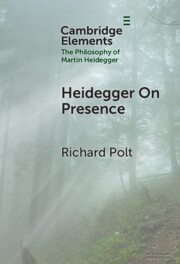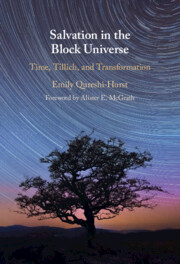433 results
Time as a medium of reward in three social preference experiments
-
- Journal:
- Experimental Economics / Volume 18 / Issue 3 / September 2015
- Published online by Cambridge University Press:
- 14 March 2025, pp. 442-456
-
- Article
- Export citation
Time for a break?: On Tanner’s vision of temporal discontinuity
-
- Journal:
- Scottish Journal of Theology , First View
- Published online by Cambridge University Press:
- 06 March 2025, pp. 1-10
-
- Article
- Export citation

Heidegger on Presence
-
- Published online:
- 04 March 2025
- Print publication:
- 27 March 2025
-
- Element
- Export citation
Spatial and temporal contexts of formal social control and system involvement: U.S. Latinos under immigration policing
-
- Journal:
- Law & Society Review / Volume 59 / Issue 1 / March 2025
- Published online by Cambridge University Press:
- 28 March 2025, pp. 172-208
- Print publication:
- March 2025
-
- Article
- Export citation

Hegel and Heidegger on Time
-
- Published online:
- 20 February 2025
- Print publication:
- 06 March 2025
-
- Element
- Export citation
1 - Metaphysics
- from Part I - The Block Universe
-
- Book:
- Salvation in the Block Universe
- Published online:
- 09 January 2025
- Print publication:
- 23 January 2025, pp 13-41
-
- Chapter
-
- You have access
- HTML
- Export citation
3 - General Relativity
- from Part I - The Block Universe
-
- Book:
- Salvation in the Block Universe
- Published online:
- 09 January 2025
- Print publication:
- 23 January 2025, pp 77-108
-
- Chapter
- Export citation
3 - Toleration, Time, and the Other
-
- Book:
- Constitutional Intolerance
- Published online:
- 09 January 2025
- Print publication:
- 23 January 2025, pp 35-50
-
- Chapter
- Export citation
2 - Special Relativity
- from Part I - The Block Universe
-
- Book:
- Salvation in the Block Universe
- Published online:
- 09 January 2025
- Print publication:
- 23 January 2025, pp 42-76
-
- Chapter
- Export citation
Introduction
-
- Book:
- Salvation in the Block Universe
- Published online:
- 09 January 2025
- Print publication:
- 23 January 2025, pp 1-10
-
- Chapter
- Export citation
Conclusion
-
- Book:
- Salvation in the Block Universe
- Published online:
- 09 January 2025
- Print publication:
- 23 January 2025, pp 256-270
-
- Chapter
- Export citation
Time perception in bipolar disorder: a systematic review
-
- Journal:
- Acta Neuropsychiatrica / Volume 37 / 2025
- Published online by Cambridge University Press:
- 23 January 2025, e5
-
- Article
-
- You have access
- Open access
- HTML
- Export citation
Association between procedure duration and adverse events in congenital cardiac catheterization
-
- Journal:
- Cardiology in the Young / Volume 35 / Issue 1 / January 2025
- Published online by Cambridge University Press:
- 21 January 2025, pp. 162-169
-
- Article
-
- You have access
- Open access
- HTML
- Export citation
Time for helping
-
- Journal:
- Journal of the Economic Science Association / Volume 2 / Issue 1 / May 2016
- Published online by Cambridge University Press:
- 17 January 2025, pp. 36-47
-
- Article
- Export citation
Economics in a world amid flux
-
- Journal:
- Behavioural Public Policy , First View
- Published online by Cambridge University Press:
- 17 January 2025, pp. 1-16
-
- Article
-
- You have access
- Open access
- HTML
- Export citation
The Nun in the Parmenides: Not Another Exaiphnês
-
- Journal:
- Dialogue: Canadian Philosophical Review / Revue canadienne de philosophie , First View
- Published online by Cambridge University Press:
- 16 January 2025, pp. 1-19
-
- Article
-
- You have access
- Open access
- HTML
- Export citation
The Rationality of Emotions Across Time
-
- Journal:
- Dialogue: Canadian Philosophical Review / Revue canadienne de philosophie , First View
- Published online by Cambridge University Press:
- 14 January 2025, pp. 1-18
-
- Article
-
- You have access
- Open access
- HTML
- Export citation

Salvation in the Block Universe
- Time, Tillich, and Transformation
-
- Published online:
- 09 January 2025
- Print publication:
- 23 January 2025
3 - Leaving a Legacy: Pentecostal Women and Timework
- from Part I - Urban Youth and Pentecostal Worlds
-
- Book:
- Youth, Pentecostalism, and Popular Music in Rwanda
- Published online:
- 19 December 2024
- Print publication:
- 02 January 2025, pp 93-120
-
- Chapter
- Export citation
Exchanged time in shared isolation: circulation of debt in Antarctica
-
- Journal:
- Antarctic Science / Volume 36 / Issue 6 / December 2024
- Published online by Cambridge University Press:
- 23 December 2024, pp. 500-513
-
- Article
-
- You have access
- Open access
- HTML
- Export citation


